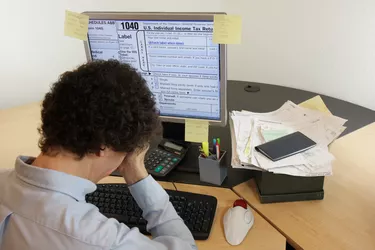
The shoebox method has been around and popular for decades. You simply place your business or personal receipts in a shoebox for the end- of-the-year tax season. There are both benefits and drawbacks to this system.
Why Receipts Are Necessary
Video of the Day
There are considerable expenses in both your personal life and in business. The Internal Revenue Service looks at some of these expenses as deductions. When you keep your receipts, you can easily prove to the IRS which expenses are deductions.
Video of the Day
Benefits of the Shoebox Method
Having a place to store your receipts and other financial data is vital. There are several reasons why this method is beneficial:
- easy to use
- diminishes clutter
- low upfront costs
- all receipts in one place
And you don't have to have a single yearly shoebox. You could have a different shoebox each month or each quarter. But the point is that once you put a receipt in your shoebox, you can pretty much forget about it until tax time. This keeps storage simple, and you don't have to worry about losing receipts.
Drawbacks of Shoebox Recordkeeping
The shoebox method has several flaws:
- tax preparation procrastination
- difficulty sorting through receipts during an audit
- extra bookkeeper or accountant costs.
Damage to the receipts is another possible drawback. Although you think your receipts are safe in the shoebox, they can rub against each other, causing the ink to fade. That makes them difficult to read and sometimes renders them useless.
Consider also: How to Get Copies of Credit Card Receipts
Recordkeeping Procrastination
By using the shoebox method of recordkeeping, you are delaying the organization required for tax preparation that lies ahead. Whether you're a freelancer, business owner or individual, you must deal with the IRS every April 15. Putting off the inevitable organizational task makes tax time more difficult.
Difficulties During an Audit
Many people think that the shoebox method makes it easier if they are audited. After all, the receipts are all in one place. So you might think you're covered and that handing the box over to an IRS agent will suffice and prove your expenses are legitimate.
But this isn't the case. The IRS expects your documents, including receipts, to be organized. They will not sift through a box. Instead, you're forced to organize and build a complete picture as to what your receipts and other financial information mean.
Not having an organized system could be a red flag during an audit. This could cost you.
Consider also: The Odds of a Tax Audit (And How You Can Reduce Them)
Long-Term Shoebox Method Cost
Using the shoebox method and make your recordkeeping unmanageable. Handing your shoebox to your bookkeeper or accountant to organize takes time. Time is money. In general, an account's fee is anywhere from $30 to $100 an hour. But 50 percent of CPAs charge a flat fee based on the amount of work. By not organizing your receipts and other records, you end up with a large bill that you could have avoided.
Alternative Recordkeeping Method
An alternative to the shoebox recordkeeping method is going digital. Your receipts could be converted and filed digitally. Several apps are available for scanning receipts.
When choosing an app, make sure it's secure and check where the storage of your receipts will be. You'll also want to know what format the files will be in. You don't want to spend time converting them to your digital accounting system. That would defeat the purpose.
Keep in mind that the IRS says that you can use any recordkeeping system suited to your business that makes it easy to see your income and expenses; however, the IRS is also now using electronic accounting and is likely to prefer reviewing digital records in the case of an audit.
- LinkedIn: A Short Box of Receipts
- Trending Accounting: Meaning of Shoebox Accounting
- S.H. Block Tax Services: Why is it Important to Keep Receipts
- AdvisoryHQ: How Much Does a CPA Cost|Guide to CPA Fees & CPA Fee Schedule
- Ageras: What Does an Accountant Cost
- IRS:Use of Electronic Accounting Software Records; Frequently Asked Questions and Answers
- IRS: What Kind of Records Should I Keep